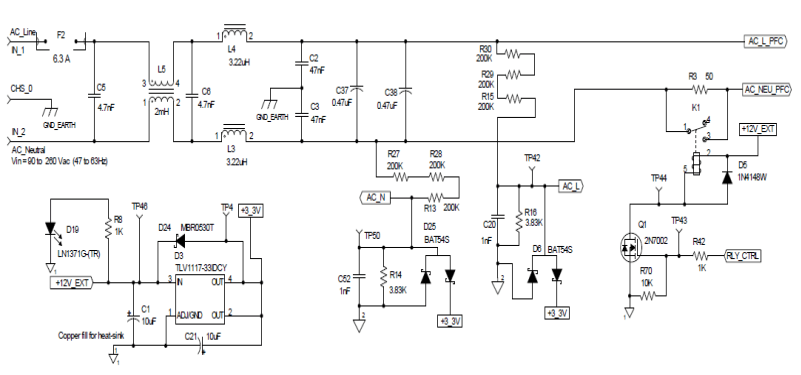SLUU885C March 2012 – June 2024 UCD3138 , UCD3138064 , UCD3138064A , UCD3138128 , UCD3138A , UCD3138A64
- 1
- 2
- Abstract
- 1 Introduction
- 2 Description
- 3 Electrical Performance Specifications
- 4 Schematics
- 5 Test Setup
- 6 List of Test Points
- 7 List of Terminals
- 8 Test Procedure
- 9 Performance Data and Typical Characteristic Curves
- 10EVM Assembly Drawing and PCB Layout
- 11List of Materials
- 12Digital PFC Description
- 13Evaluating the Single-Phase PFC with GUI
- 14Monitoring, Re-configuring and Re-tuning with Designer GUI
- 15Digital PFC Firmware Development
- 16References
- 17Revision History
12.3.1 PFC Pre-Regulator Input
The power entry section, PFC pre-regulator input, as shown in Figure 12-7, consists of EMI input filter, AC voltage sense circuit and inrush relay control circuit. The series resistor R3 limits the inrush current. The inrush control relay K1, controlled by the UCD3138 controller, is used to bypass this resistor. The controller measures input and output voltages and decides the appropriate time for closure of this relay. Input AC voltage is scaled and conditioned, and the sensed signal is applied to the UCD3138 ADC input AD_07 and AD_08. Figure 12-7 also shows a DC voltage regulator D3, which converts the 12 V into 3.3 V to provide the bias for on-board 3.3 V.
 Figure 12-7 AC Power Filtering, Inrush Current Limit and AC Voltage Sense
Figure 12-7 AC Power Filtering, Inrush Current Limit and AC Voltage Sense